
Dilator use during and after menopause may reduce vaginal pain and discomfort.
During and after menopause, lower estrogen levels can lead to genitourinary syndrome of menopause (GSM), which may cause:
- Vaginal dryness
- Thinning of vaginal tissues
- Painful sex
- Narrowing or shortening of the vaginal canal
- Vaginal atrophy or stenosis (hypoestrogenic)
The vagina opening or canal becomes less elastic and doesn’t expand as easily. This can lead to painful insertion of tampons, penetration, or gynecological exams and sexual withdrawal or avoidance.
How They Work:
- Dilators consist of round instruments made of silicone or medical-grade plastic.
- They’re an insertable cylinder in the shape of a finger to the size of a penis or medical speculum.
- They are inserted gently into the vagina, starting with the smallest size.
- Over time, you progress to larger sizes as comfort improves.
This helps maintain or regain the ability to have comfortable intercourse, pelvic exams, or penetration of any type.
Dilators are typically used 3–5 times throughout the week, with each session lasting from 5 to 10 minutes.
With proper usage and guidance from a menopause provider, you may find significant relief and increased vaginal health. If inserting dilators is painful, try using a high-quality, hormone-free vaginal lubricant.

